The False Ashoka Complacency (and Other Stories)
First published in Sanctuary Asia,
Vol. 43
No. 10,
October 2023
By Pranav Capila
Don't Ask, Don't Tell
On June 5th, World Environment Day, my neighbourhood Residents Welfare Association (RWA) planted 300 Ashoka trees in a carefully regimented deployment around the colony. Photographs of the Visiting Dignitary planting saplings were taken, backs were patted, congratulatory messages about ‘green warriors’ and ‘environmental consciousness’ pinged to and fro on the official WhatsApp group.
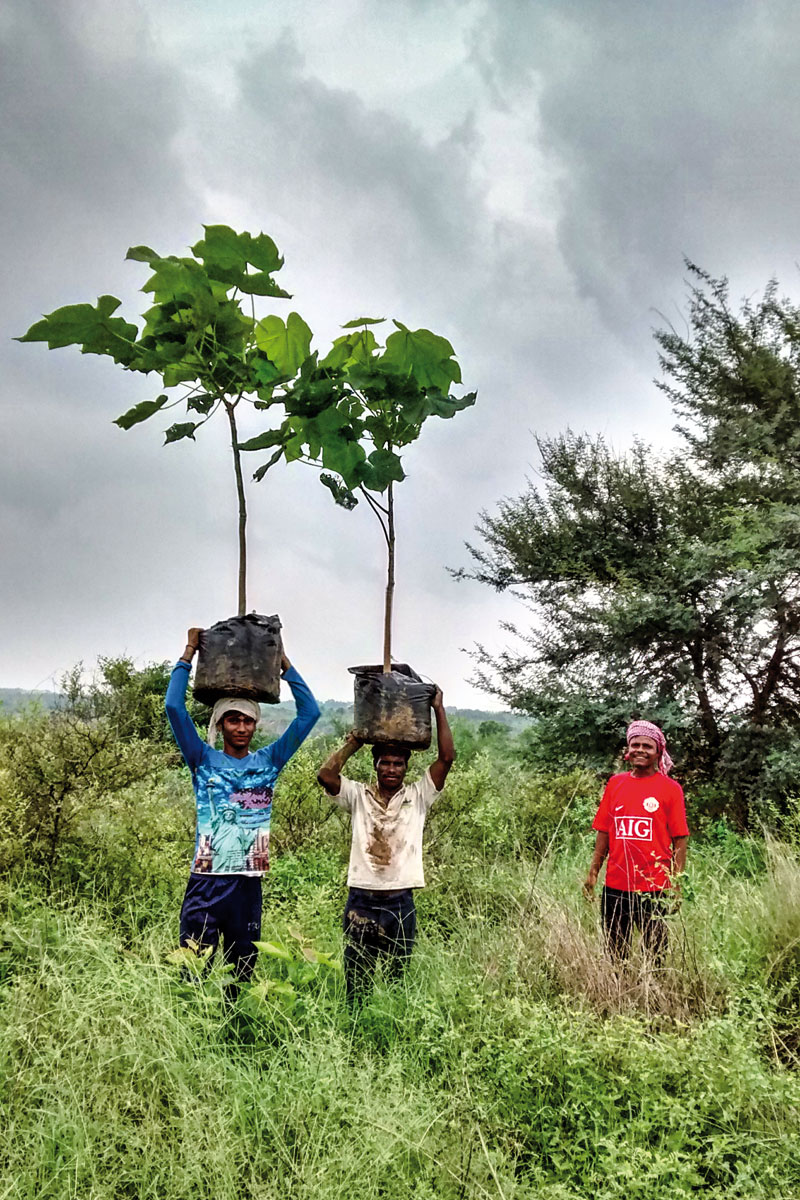
Planting activities during the monsoon at the Aravali Biodiversity Park, in the midst of Gurugram. The Aravali Biodiversity Park could well have been just another mishmash of misplaced tree-planting zeal, but the efforts of the last 12 years have ensured that it is indeed an actual forest, albeit a very young one. Photo: The Rewilders.
Ashokas are not native to India’s National Capital Region, where I live. They are, in fact, not even Ashokas – that is, they are not Saraca asoca, the vulnerable rainforest species with roots sunk deep into Indian mythology and history, but Monoon longifolium, also known as the ‘False Ashoka’. It doesn’t matter. Like a lie told often enough, the False Ashoka has now become the Ashoka. And true or false, endemic or exotic, a tree is a tree. And planting trees is good for the environment.
So, plant a tree. Plant many trees. What trees, why and where? Don’t think about it. Why would you, when the people who really ought to, aren’t? There’s a movement for mindless tree-planting raging through the country. People are doing it. Forest Departments are doing it. Corporates are funding it. Governments are extremely happy with it. Join in; the mindlessness is precisely the point.
Once you accept that a tree is a tree, you can accept that a collection of trees is a forest. A grove is a forest, an orchard is a forest, a plantation is a forest. A zoo is a forest, a safari park is a forest, heck, even your neighbourhood park can be a forest, as long as it seems sufficiently so via satellite. Accept that India’s forest cover is increasing, one monoculture plantation at a time. Accept that laws sanctioning mass forest diversions can be passed without a whimper, because a safari park in Haryana will compensate for the destruction of an old-growth rainforest in the Andamans. Accept that you can consume your forests and have them too. Compensatio erat demonstrandum.
Don’t say that a lot of the forests that are being planted to ‘compensate’ for natural forest loss, or positioned as carbon credits that can be bought by companies to offset emissions, aren’t actually forests. Don’t even read the title of that study in Nature (‘Restoring natural forests is the best way to remove atmospheric carbon’, April 2019), which revealed that almost half (45 per cent) of the areas that countries have pledged to restore to combat global warming are set to become plantations of commercial trees. (“There is a scandal here,” lead author Simon Lewis of the University College, London was quoted as saying. “To most people, forest restoration means bringing back natural forests, but policy makers are calling vast monocultures ‘forest restoration’. And worse, the advertised climate benefits are absent.”)
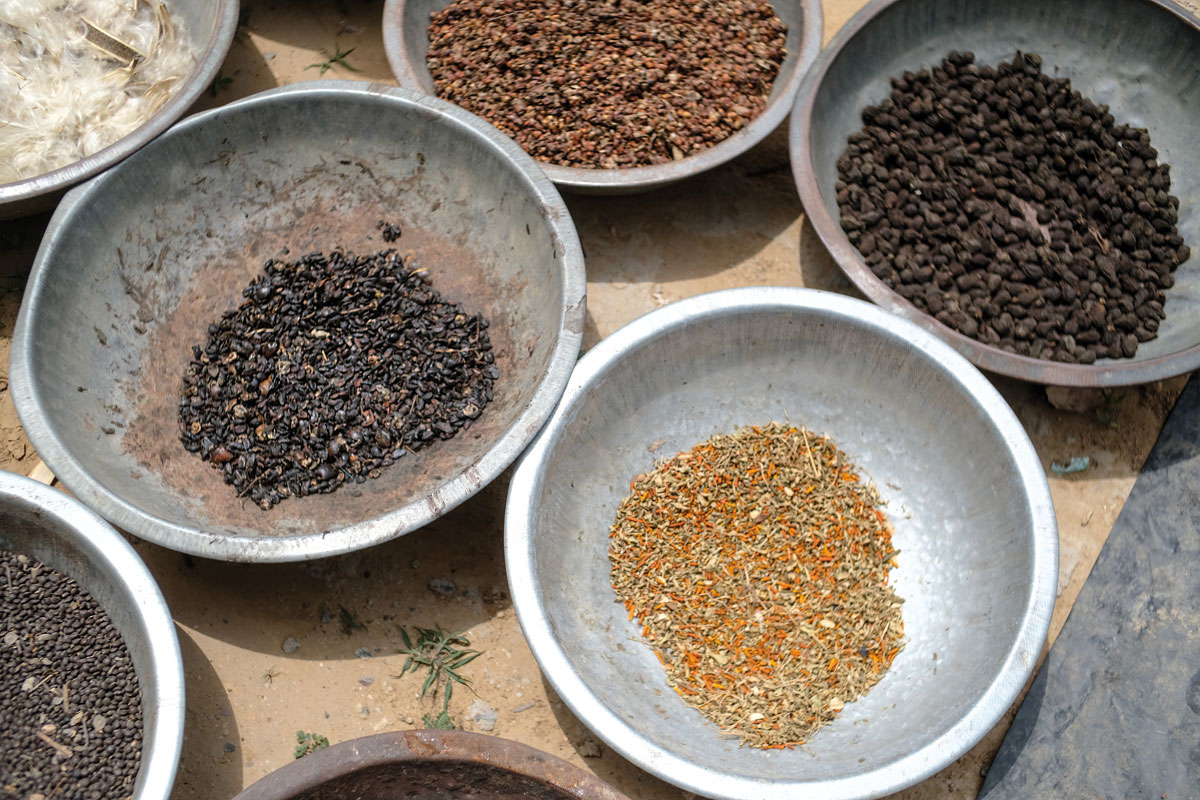
As part of the ecological restoration plan for Aravali Biodiversity Park, seeds were collected from remnant natural forests and vegetated areas in Mangar, Nahargarh and Kumbhalgarh in the Aravali Range, and two nurseries were established to raise seedlings. Photo: Vijay Dhasmana.
Don’t say that the ‘reforestation’ of degraded natural forests with fast-growing monoculture plantations is tantamount to creating green deserts owing to the limited biodiversity they will sustain. Don’t say that the ‘afforestation’ of open natural ecosystems such as scrublands, grasslands and wetlands is “an incongruous disturbance and, indeed, an impending ecological disaster” (Fernandez, GW, et. al., Perspectives in Ecology and Conservation, July-Dec 2016). Don’t point to the 2022 analysis (Rana P., et al., ‘Predicting wasteful spending in tree planting programmes in Indian Himalaya’; World Development; June 2022) that found that “tree planting programmes involve considerable wasted expenditure on ineffective plantations, [raising] questions about optimistic assessments of [their] potential to serve as a cost-effective natural climate solution”. India has pledged to restore 21 million hectares of forest by 2030 under the Bonn Challenge. Don’t you want us to win?
Don’t say that actually ‘Preventing, Halting and Reversing Loss of Nature’ (the slogan of the United Nations Decade on Ecosystem Restoration) requires scientifically robust restoration projects attuned to each ecosystem and ecoregion. Projects such as the ones featured in the pages here, that are working to reverse degradation, recover biodiversity and restore ecosystem services, in close cooperation with local communities. Don’t, whatever you do, read about them.
The Forest In My Backyard
There’s a forest in my backyard that I had never visited until a few months ago, probably because I never thought of it as a forest. I mean, sure, the 158 ha. Aravali Biodiversity Park (ABDP) was once an abandoned mining site, dry and degraded, and now there are trees and shrubs and grasses. But some park in Gurgaon of all places can’t be compared to a real forest. Can it?
Rewilder and eco-restoration practitioner Vijay Dhasmana receives my cynicism towards the city forest he has curated with good humour. The Aravali Biodiversity Park could well have been just another mishmash of misplaced tree-planting zeal, but the efforts of the last 12 years have ensured that it is indeed an actual forest, albeit a very young one.
In 2010, when Dhasmana was approached by the citizen-led movement IAmGurgaon (IAG), their excitement was about planting a million native trees – although their concept of ‘native’ was not very clearly defined. Dhasmana asked them to take a step back. “I took them to Mangar Bani, Jhir, Sariska… different parts of the Northern Aravalis,” he says, “and told them, look, it won’t be just about trees, it will be about restoring the land to its original shape.”
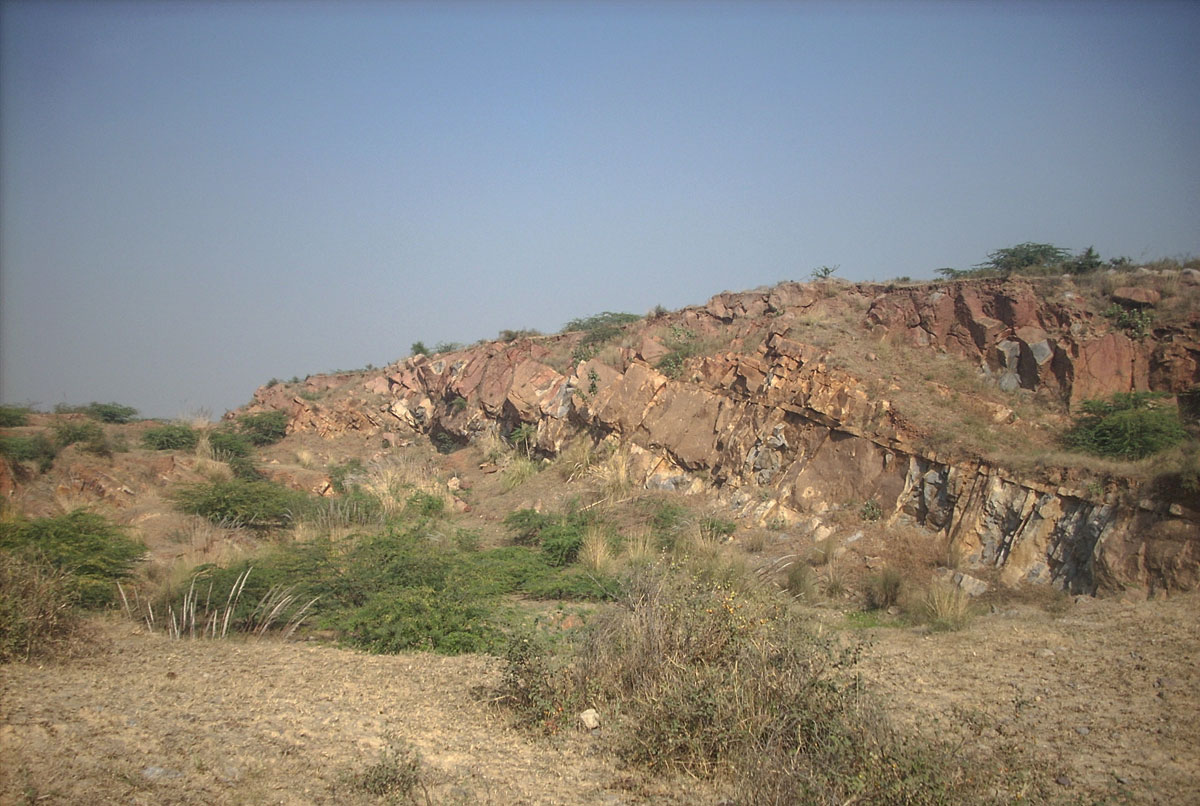
A cliff in the Aravali Biodiversity Park, 2010. Photo: Atal Kapoor.
IAG listened. And although the sponsorship money still came for tree planting (an easier CSR sell), a nuanced plan for ecological restoration came into being. Reference sites were studied to see how different species supported one another in various tiers of the Northern Tropical Dry Deciduous and Northern Tropical Thorn Forest ecosystems, which are characteristic of the region. An inventory of over 200 desirable native species of trees, shrubs, climbers and grasses was made. Climax species were identified – Indian frankincense Boswellia serrata and the dhok tree Anogeissus pendula on the rocky hills; dhak tree Butea monosperma dominated mixed deciduous patches in sandy and gravel areas; and saccharum-phoenix savannahs in the periodically inundated areas – to envisage how the forest, once mature, undisturbed and self-sustaining, would manifest in the decades to come. Seeds were collected from remnant natural forests and vegetated areas in Mangar, Nahargarh and Kumbhalgarh in the Aravali Range, and two nurseries were established to raise seedlings. Invasive alien species such as the vilayati kikkar tree Prosopis juliflora were removed and native seedlings planted.
“We also made some mistakes along the way,” Dhasmana says as we walk through off-path areas of the ABDP on a muggy June morning. He points to an indrajau tree Holarrhena pubescens: “You can see this one isn’t flowering; we planted it with the pioneer species but it needs canopy cover; it should have come in when the forest was more mature.”
We walk by a saccharum patch, sending a monitor lizard scuttling to safety, then halfway up a ridge where the rocky perch of an Indian Eagle-owl Bubo bengalensis is littered with the bones of its prey, then up to the top, with Indian frankincense growing on the brow (“the way you see it in Mangar Bani”) and a dhok forest patch behind (“now quite dense”). He points to a Boswellia seedling sprouting from a crack in a rock: “This is natural recruitment. Its seed would have dispersed, lodged here and sprouted. See how happily it has survived the harsh summer in these rocks!” The native plants in ABDP are naturally hardy and doing quite well, but at 10 years, this forest is still in its infancy. “As the forest matures, we will have to continuously study it to see what’s growing and what’s not, how it reacts to particularly dry or wet years, and how its natural cycles unfold. When you plan a climax forest you hope that the forest, with the human disturbance removed, with invasives managed, will sustain itself. It will become stable. But monitoring it over large timescales is a resource intensive task, and the timescales in ecological restoration are always very large.”
In 2022, the IUCN declared ABDP India’s first other effective area-based conservation measures (OECM) site, indicating an area that is not protected but supports a rich biodiversity.
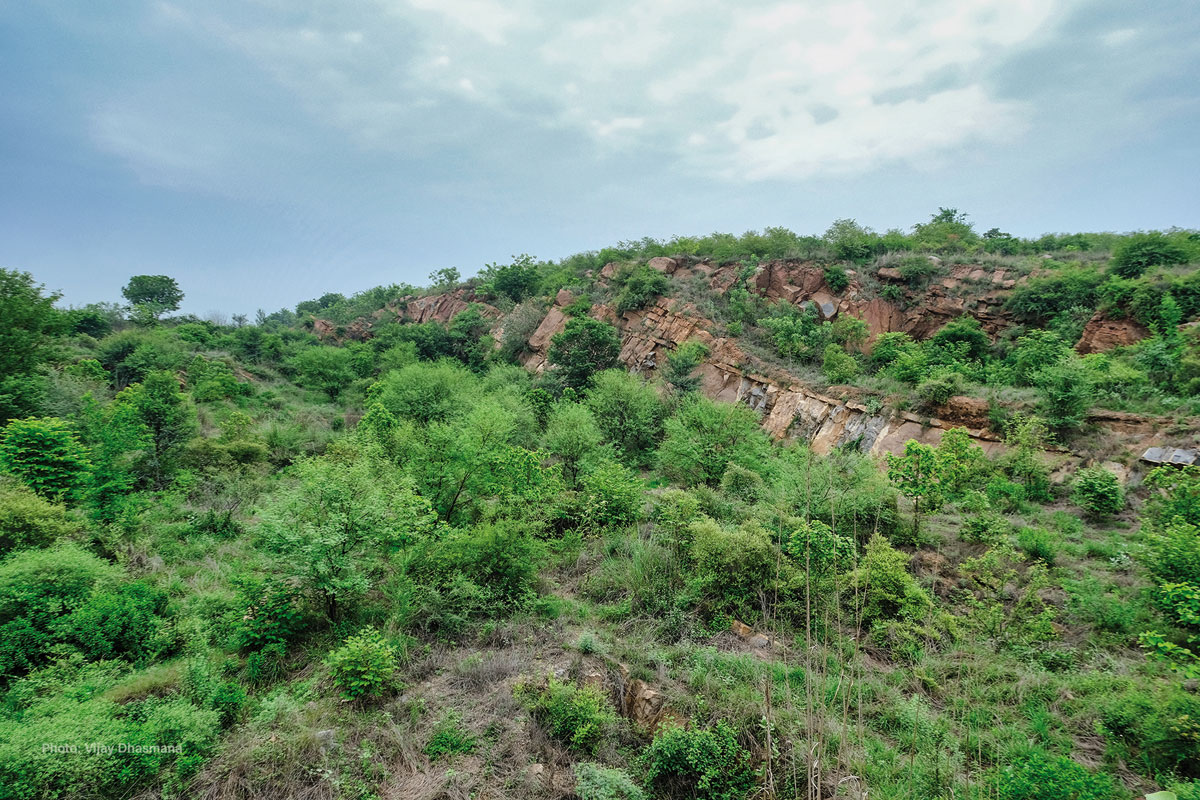
The same cliff in 2020. Photo: Vijay Dhasmana.
Apart from its floral wealth, the park supports several mammal species, including golden jackals, jungle cats, nilgai, flying foxes, grey mongoose, small Indian civets and Indian hares. It is also an eBird hotspot with over
206 avian species recorded so far, boasts a variety of reptiles, and has a rich invertebrate diversity too.
ABDP’s success has led to other projects for The Rewilders, Dhasmana’s organisation. These include Aravali Nagar Van, a 72 ha. area a stone’s throw from ABDP where Prosopis patches are gradually being thinned out and the Northern Aravali forest community of plants reintroduced; a 90-acre site in Sikandarpur, encompassing rocky outcrops and ‘bhood’ areas (sandy foothills that are vital for groundwater recharge); and two important forest corridors, Chakkarpur-Wazirabad and Badshahpur, in partnership with IAmGurgaon, the Haryana Forest Department and the Gurugram Metropolitan Development Authority.
There is much work being done, and much to be done.
Protected But Vulnerable
The buffer area of the Bandipur Tiger Reserve, like other tiger reserves across the country, has historically faced a lot of biotic pressure. The reserve forests here have been badly denuded by cattle grazing, firewood collection and other human activities.
When Bengaluru-based NGO Junglescapes began working in the Bandipur buffer in 2008, there was no model to follow for ecological restoration in a Protected Area (PA). A pilot project was started on a single hill adjoining a village, in coordination with the village’s Eco-Development Committee. Then another village joined in and another hill was taken up. Gradually, organically, the project grew. Fifteen years later, it spans over 1,200 ha. across the buffer and the core.
“The major credit for what we’ve achieved in Bandipur goes to the local community,” says Ramesh Venkataraman, managing trustee of Junglescapes and a Certified Ecological Restoration Practitioner. “Yes, we’re providing livelihoods to indigenous people through the restoration work. But that is secondary. The primary outcome is that the reconnection with the forests helps preserve their traditional ecological knowledge.”
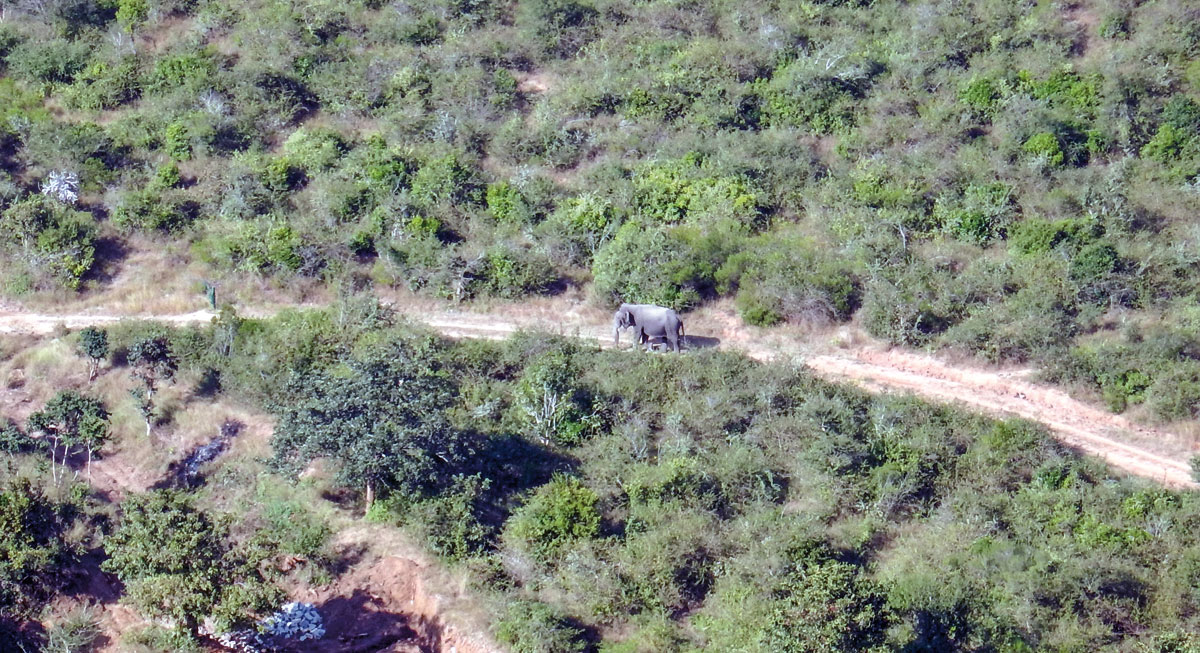
An elephant walks through restored areas in the Lokkere Reserve Forest. Ecological restoration in buffer areas can expand wildlife habitats and protect migratory corridors. Photo Courtesy: Junglescapes.
Marrying the intimate ecological knowledge that Indigenous people have of their environment with high-level scientific knowledge, Venkatraman believes, is crucial to the long-term success of such projects. For instance, Junglescapes worked in the seven square kilometre Lokkere Reserve Forest, which has different types of terrain: hilly slopes, where soil compaction, rainwater run-off and denudation were the major issues, and low-lying areas, where invasives had colonised large portions. The local people knew the soil types in different areas, where water harvesting would (or wouldn’t) work, where various native species had historically flourished, and where seed-bearing mother trees of desirable species could be found. While scientific knowledge on lantana removal, for example, could be researched, that kind of micro-knowledge about the land could only come from the community.
Junglescapes has trained community members to remove lantana through the proven ‘cut rootstock method’. Getting native grasses back, though, is the crucial next step. The grasses cover the ground quickly, alleviate the soil and provide a reasonable defence against lantana re-emergence. Then, the pioneer species can return. The team usually collects grass seeds during the seeding season in January and February. Grass slip transplanting is also performed. While seeds of shrubs, climbers and trees are also collected and planted where required to fill species’ gaps, the team has found that once the lantana has been removed and grass cover restored, a lot of regeneration happens on its own. “We’ve seen that whatever comes back naturally, through Assisted Natural Regeneration, is far more resilient and far more suited to this particular landscape,” Venkataraman says.
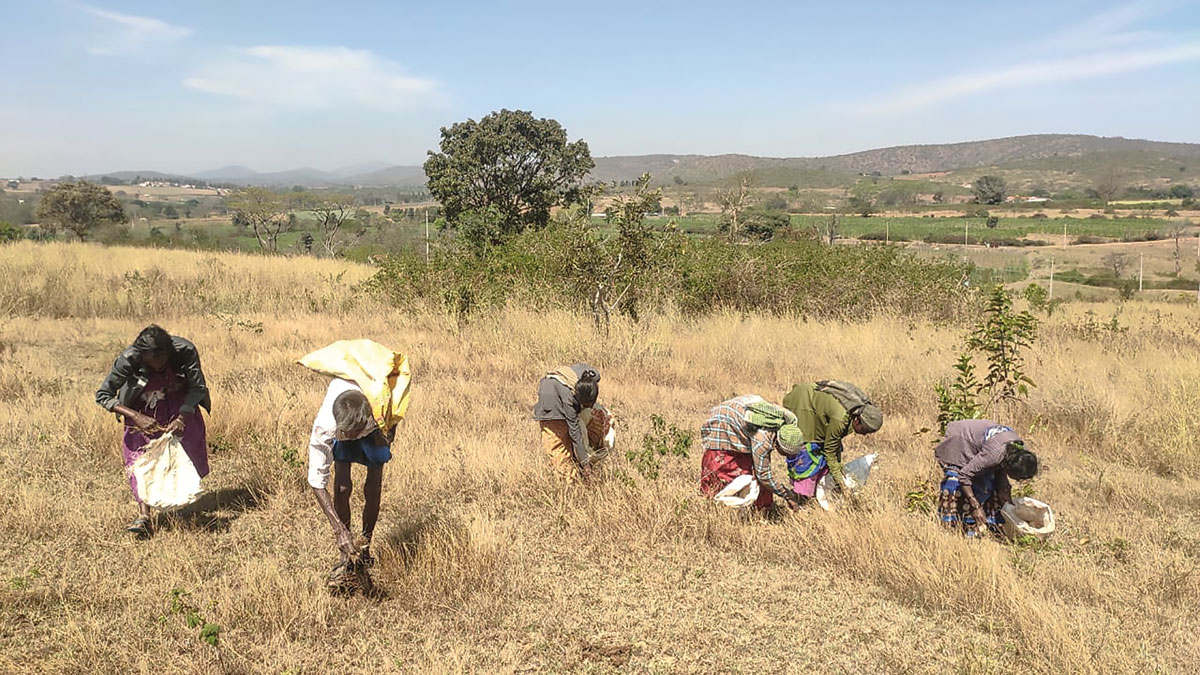
Grass seed collection by Junglescapes’ Indigenous restoration partners. The success of rewilding in this landscape can be attributed to the participation of the local community. Photo Courtesy: Junglescapes.
A survey conducted last year in the dry deciduous forests under restoration revealed that there were now about 350 species of plants, including 100 tree species and 180 herbs and shrubs, apart from climbers, creepers and grasses – a diverse structure representative of the forest type. Forests in Bandipur range from sub-tropical thorn (mainly in the buffer) to predominantly dry deciduous; unlike moist deciduous or rainforests, they are meant to have a lot of open-to-sky area, with a plenitude of grasses and shrubs. Intensive tree-planting drives in such forests can lead to a denser canopy and ecosystem alterations.
Venkataraman believes that there is a lot of work to be done inside PAs around the country. “PAs are legally protected but ecologically vulnerable,” he says. “Scaling up ecological restoration is a major challenge and it is only the government, not individual NGOs, that has the capacity to implement projects at a scale that makes a difference.” For reference, Bandipur is a 912 sq. km. park with lantana having invaded about 50 per cent. Junglescapes has been able to cover about 1,200 ha. (12 sq. km.) in 15 years: an impressive figure in itself, but a tiny percentage in the larger scheme of things.
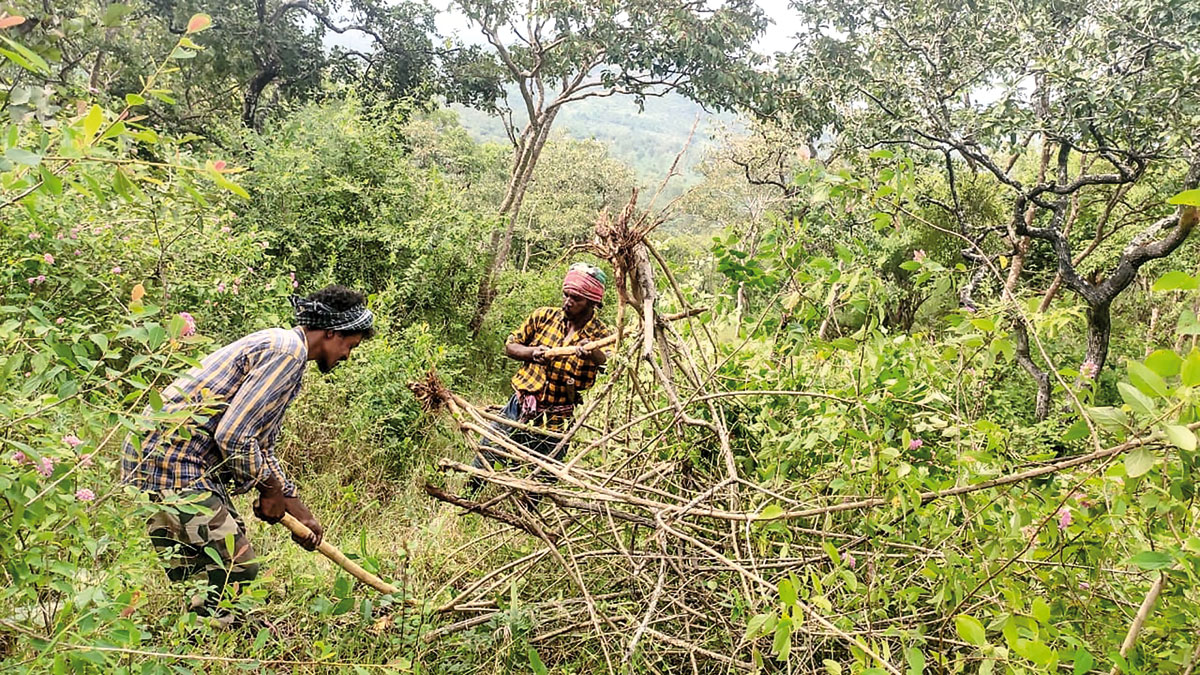
Junglescapes has trained community members to remove lantana through the proven ‘cut rootstock method’. Getting native grasses back is the crucial next step, since grasses cover the ground quickly and provide a defence against lantana re-emergence. Photo Courtesy: Junglescapes.
Forest degradation in PAs is one of the reasons why wildlife, including megafauna such as tigers and elephants, are being forced into surrounding landscapes, resulting in human-wildlife conflict. Particularly in buffer areas, ecological restoration can improve forest cover, expand available habitats for wildlife, and protect vital migratory corridors. While most restoration projects target areas outside PAs, improving forest quality within them is critical.
Kandals And Corals
In May 2017, while researching a story on elephant corridors in the Brahmagiri-Nilgiris-Eastern Ghats landscape, I made a detour to the coastal backwaters of Kunhimangalam, a small village in the Kannur district of Kerala. Wildlife Trust of India (WTI) had acquired 7.55 ha. of species-rich mangrove habitat here, which in 2016 became the hub for the Kannur Kandal (Mangrove Conservation) Project, aimed at promoting the restoration of mangroves in Kerala by fostering community and government participation.
The project’s small nursery at Thuruti was supplying saplings for volunteers to plant, and students from across Kannur regularly visited the Mangrove Interpretation Centre. They learned about the role of mangrove ecosystems as refuges and nurseries for a variety of threatened terrestrial and aquatic species, as an important source of fodder, medicines and firewood for coastal communities, and as buffers against soil erosion, tsunamis and climatic events such as cyclones. They learned, too, how the extent of mangroves in Kerala had reduced drastically over the years, with only 1,750 ha. of an estimated historical 70,000 ha. remaining.
Of these, 755 ha. were in Kannur district, supporting at least 10 species of mangroves, 87 species of fish, 83 species of birds and 13 species of mammals, including the vulnerable smooth-coated otter. The problem was that 90 per cent of this area was under private ownership and was therefore highly threatened.
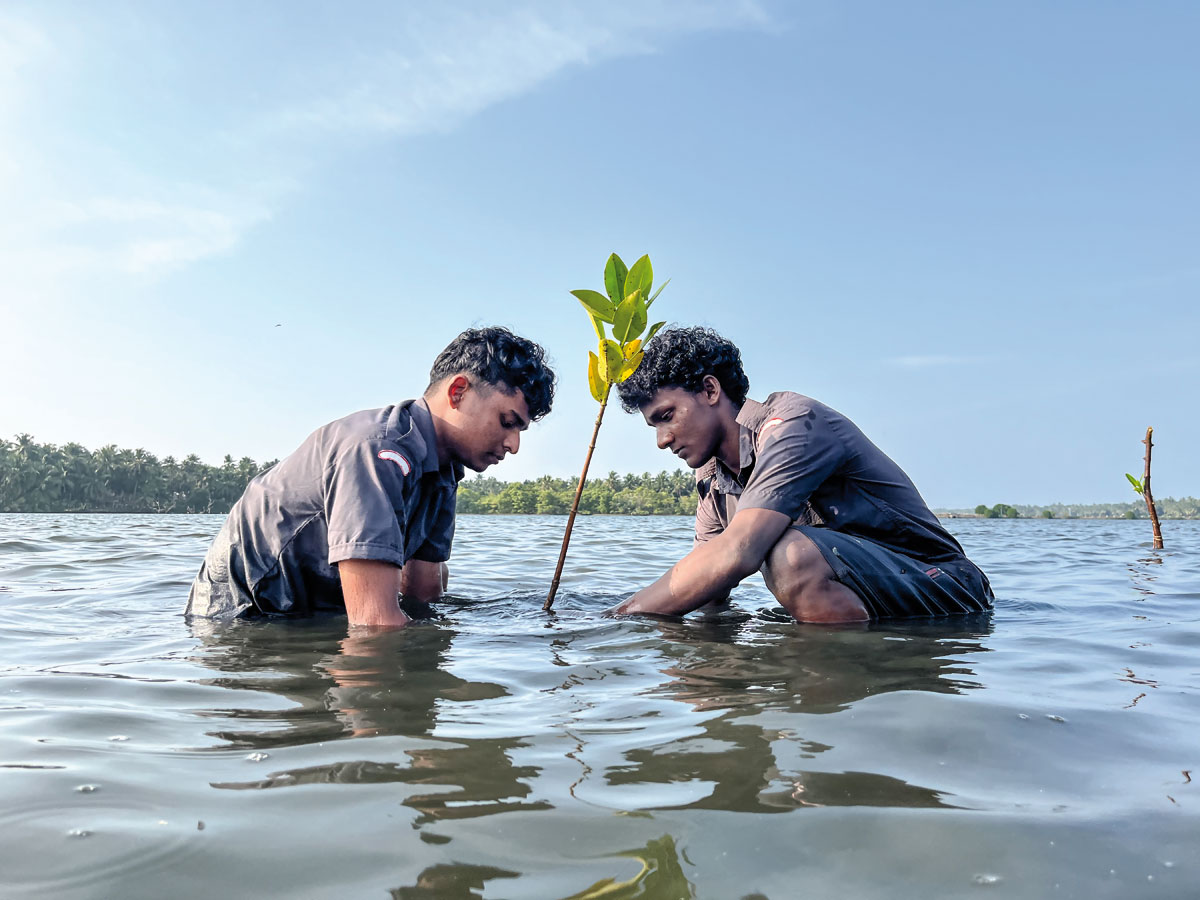
Mangrove planting at the Kannur Kandal Project. Three panchayats in Kannur have given permission for mangrove restoration in their areas and surveys are being conducted to identify degraded sites. Photo Courtesy: Vimal/WTI.
As I walked the perimeter of the secured kandals with project lead Ramith M., I saw very few mangroves remaining on adjacent lands. Instead, there were coconut plantations and ponds for aquaculture, which was being subsidised by the government. On the adjoining Perumba River, Shaju, a local fisherman, told us that his catch of mangrove red snapper had dwindled to nothing; he had been fishing since childhood and this had been his worst year in living memory.
In the years since I visited, the Kannur Kandal Project, supported by the Kerala Forest Department and SBI Foundation, has provided greater impetus to its restoration activities. Three panchayats in Kannur have now provided permission for mangrove restoration in their areas and surveys are being conducted to identify degraded sites. Capacity building of local fisherfolk, forest department personnel, school and college students, and other volunteers in restoration planting is also ongoing. Further, a Central Mangrove Nursery with a capacity of one lakh saplings is being created, which will have all 18 true mangrove species (and a few mangrove associates) of Kerala. The aim is to restore 12 ha. of degraded areas in Kannur over the next two years, and 40 ha. in the longer term. The broader plan is to establish a model for the securement and restoration of mangrove areas that can be scaled up and implemented across Kerala and elsewhere.
A Marine Rewilding
Another WTI project that I hope to visit soon, a joint venture with the Gujarat Forest Department, is working to recover the degraded Mithapur coral reef that lies 12 km. south of the Gulf of Kutchh in Gujarat. Restoration activities are being undertaken over a 500 ha. area, with a long-term goal to restore 1,200 ha.
Coral reefs, also known as the rainforests of the seas, are among the most threatened ecosystems on the planet. They are hotbeds of biodiversity, serving as shelter, reproduction, feeding and nursery areas for an estimated 25 per cent of all marine species. They also play a key role in climate adaptation: a meta-analysis published by Nature in 2014 on the effectiveness of coral reefs for coastal hazard risk reduction and adaptation revealed that they reduce wave energy by an average of 97 per cent. In addition, they create livelihood opportunities for coastal communities through fisheries and tourism. Figures released in 2018 by the United Nations Environment Programme (UNEP) as part of a ‘coral reef funding analysis’ estimated that coral reef ecosystems “provide society with resources and services worth $375 billion per year”.
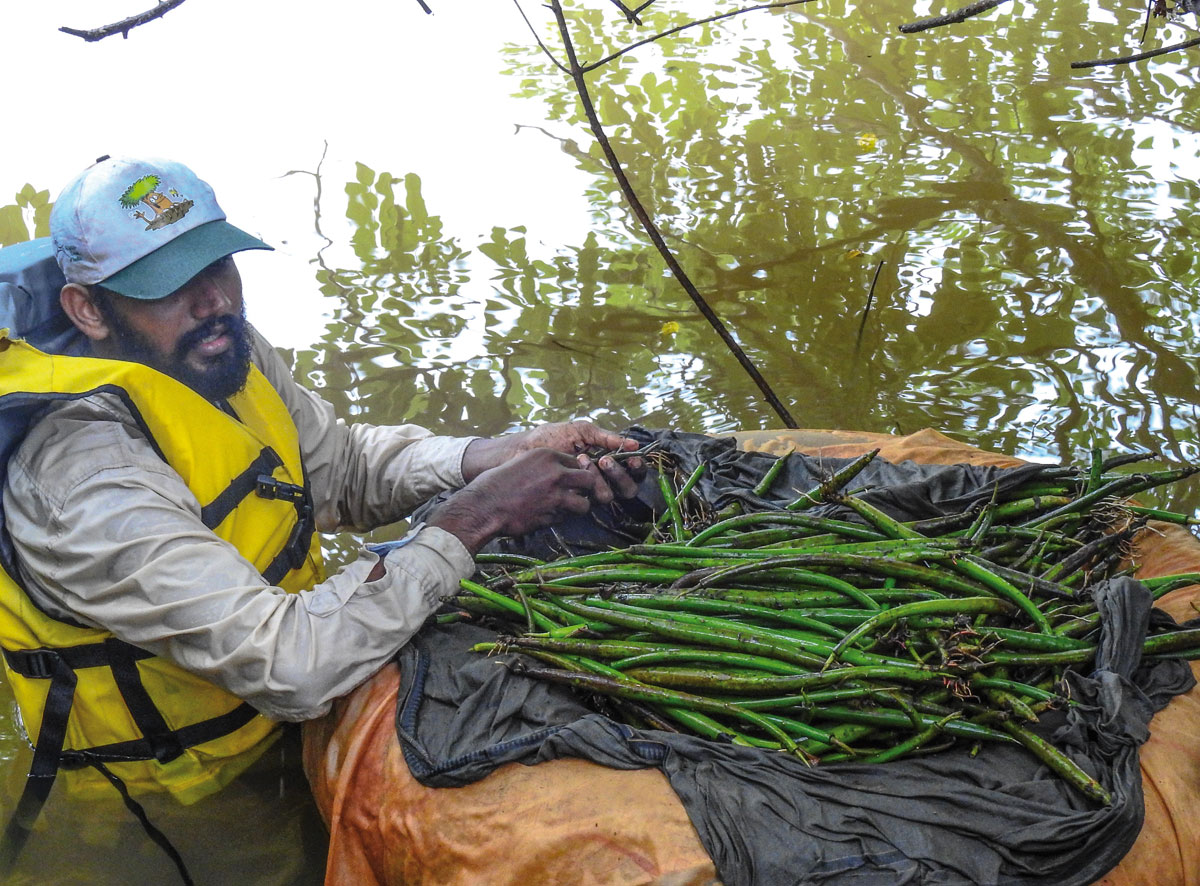
A mangrove planting drive on the Perumba River. The Perumba has been losing its native biodiversity as mangrove areas have been replaced by coconut plantations, aquaculture ponds and human infrastructure over the years. Photo Courtesy: WTI.
The Mithapur Coral Reef Recovery Project has previously reintroduced two locally extinct species through an unprecedented transplantation from donor sites in Lakshadweep. The most recent restoration activities have involved the use of Biorock, a mineral accretion technology used to make robust artificial reef structures on which corals can grow at rapid rates.
By The People
The village of Changlangshu lies on the eastern edge of Nagaland, about halfway up the palm that India cups to Myanmar’s cheek. A long time ago it was surrounded by dense community-owned forests, but no longer, not for many years now.
As the human population grew, more and more forest land was appropriated for settlements, logging and jhum (shifting) cultivation. The forests that remained were fragmented into small, disconnected patches that became degraded over time. Members of the Indigenous Konyak tribe noticed that many of the wild herbs and plants that they had used – in their food, medicines or various cultural practices – were disappearing. So too were the birds and animals that formed an intrinsic part of their folklore. Rainwater run-off from the now-exposed hill slopes had also led to the depletion of water tables, resulting in a water crisis. But there were more mouths to feed, so more forests were cleared. The fallow cycles of jhum grew shorter, giving the forests almost no time to regenerate.
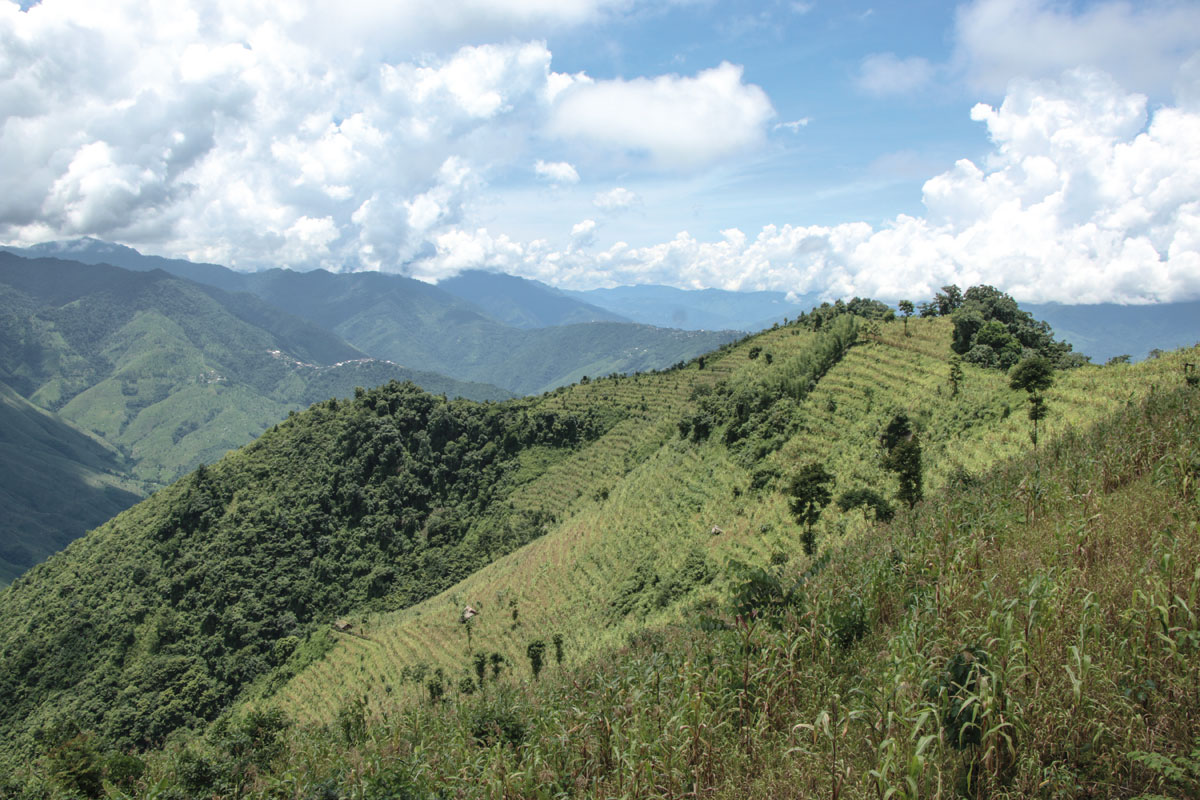
The current Changlangshu Biodiversity Management Committee (BMC) restoration site (at the top of the denuded hill). The BMC is working long-term towards connecting three small forest patches by restoring the fallow jhum lands that lie between them, forming a single permanent forest area of around 100 ha. Photo Courtesy: Changlangshu BMC.
An interest in wildlife filmmaking led Wanmei Konyak, who once used to hunt in these forests, to a Green Hub fellowship in 2015-16. Successive internships with Wildlife Trust of India (WTI) and the Wildlife Institute of India (WII) followed, nurturing an incipient interest in conservation. In 2018, when Green Hub began its ‘Youth for Forest’ initiative, creating small grants for alumni who had shown an interest in working on biodiversity conservation within their communities, Wanmei was the first recipient.
Along with a group of friends, he formed a Biodiversity Management Committee (BMC) in the village. “When we started out, we didn’t have a designated area for restoration activities,” he says. “We were just planting saplings along roads near the forests. Every piece of land in Changlangshu is owned by individuals or clans, and since there was no precedent here for the kind of work we were doing, it was difficult to make people understand.”
The BMC team began attending Village Council meetings and speaking to community leaders about the need for biodiversity conservation. Restrictions were sought, and eventually granted, on hunting in community forest lands. A senior member of the community donated a patch of degraded forest, formerly a resting area for migratory birds, to the BMC for restoration. The Village Council also helped set up a nursery for native plants at the primary health centre. By 2019, the team had started planting saplings on the donated land. As awareness about their work grew, other members of the community began to donate their jhum lands to the BMC.
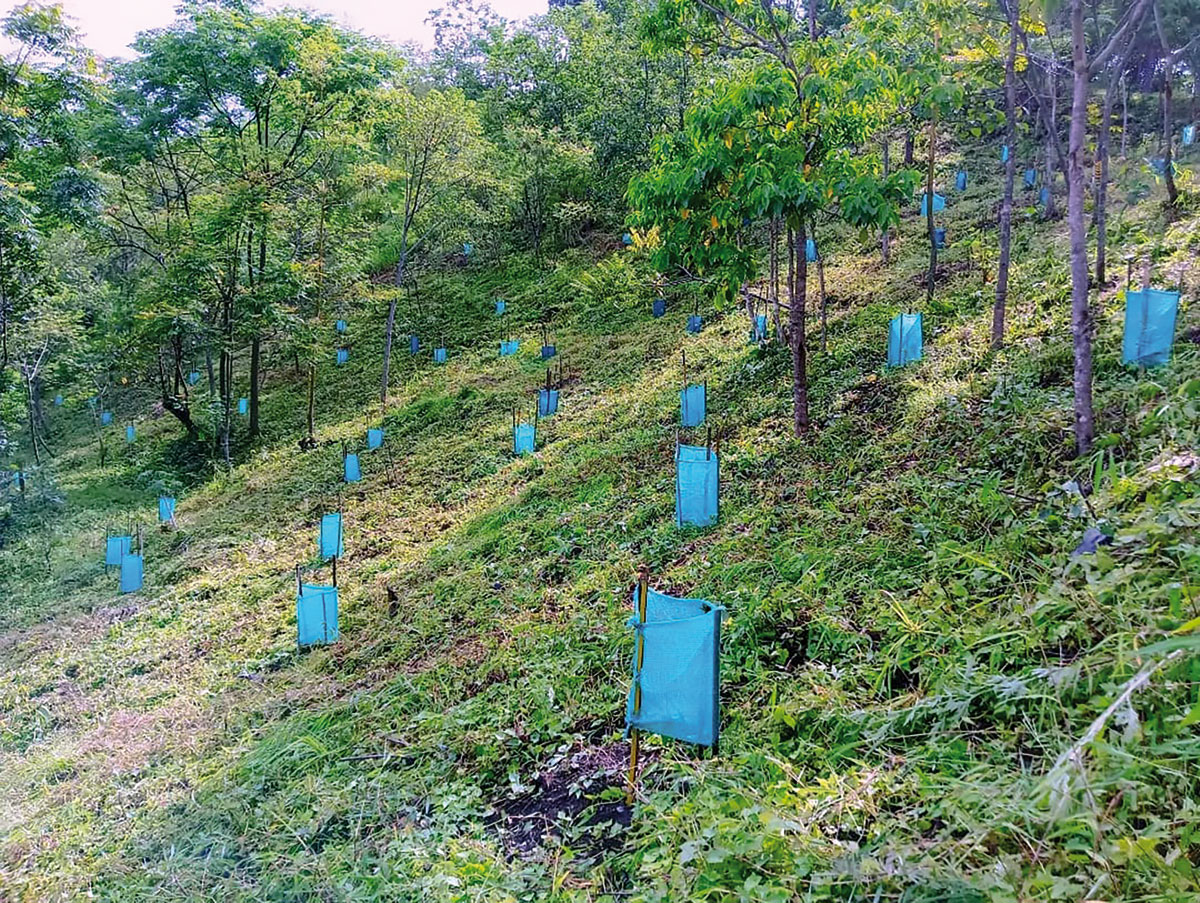
The protected saplings at the Changlangshu BMC restoration site. Photo Courtesy: Changlangshu BMC.
Green Hub has provided constant support, providing regular access to training in aspects of ecological restoration for the BMC and other interested members of the community. The project is also receiving financial support through a Green Hub-Royal Enfield Small Grant. The Nature Conservation Foundation and the Ecological Restoration Alliance (ERA) have provided scientific expertise.
The current area under restoration is about 1.5 ha., with 3,000 saplings having been planted. The BMC is working long-term towards connecting three small forest patches – Eaknyak forest, Langkea forest and Obajung forest – by restoring the fallow jhum lands that lie between them, forming a single permanent forest area of around 100 ha. Agreements have been reached with the landowners through the Village Council and Changlangshu Students’ Union: the forest and its resources will be managed by the BMC, which will also promote eco-tourism in the area. Any benefits that flow from the venture will be shared with the landowners and the owners of the community forest.
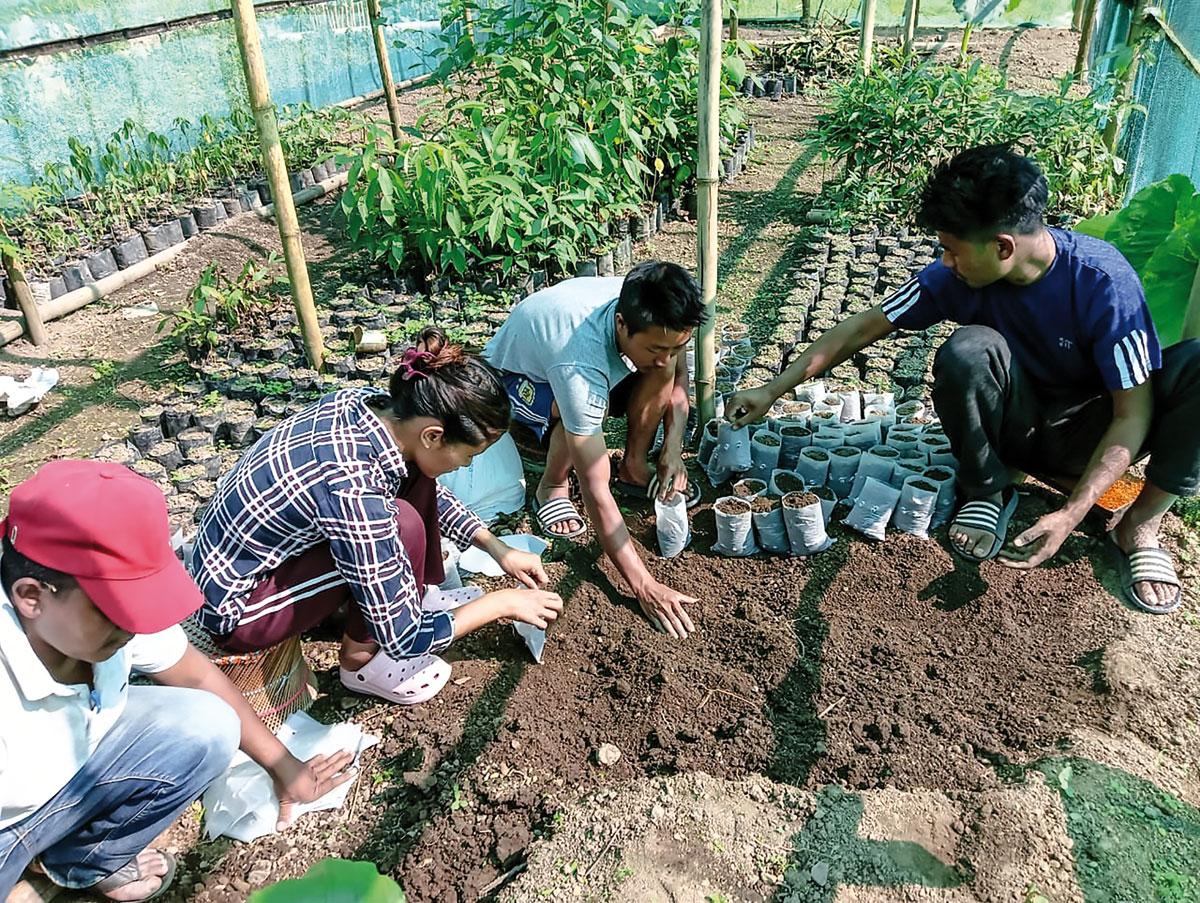
Community members planting seedlings in the BMC nursery. As awareness about the restoration work has grown, more members have donated their jhum lands to the BMC. Photo Courtesy: Changlangshu BMC.
“Ecological restoration is a long and slow process of creating and healing a forest,” Wanmei says. “Our work in the restoration area must continue in the long-term for it to make any significant impact on the forest areas around the village. But our team is deeply committed to this work. We were once just a handful of people, now we are more than 30. More will join us. These forests are our community’s future.”
With thanks to Nayantara Siruguri.
All Roads Lead To Valparai
I have a box cutter, a trowel and a pocketful of blue tags. I have this hole in the forest floor in front of me and this sapling in a nursery bag beside it. I have… no confidence.
This isn’t some garden variety sapling that I’m planting. If I manage to not kill it in this moment, it will grow, over decades, into a tall, proud rainforest tree. The sweat beading my brow has little to do with the mid-July humidity.
I am in Varattuparai, in a small rainforest fragment on the Valparai Plateau in Tamil Nadu’s Anamalai Hills. Nature Conservation Foundation (NCF) is restoring this degraded fragment, which falls within a Tata Coffee plantation, as part of its long-running Anamalai Rainforest Restoration Project. The project is supported by Rohini Nilekani Philanthropies, Rainmatter Foundation and the AMM Murugappa Chettiar Research Centre.
Yesterday, at the project’s nursery (also in Varattuparai, on Tata Coffee land), NCF project manager Kshama Bhat guided me through the two- to five-year journey that saplings typically take before they’re deemed ready to plant. It begins, as such journeys do, with a seed.
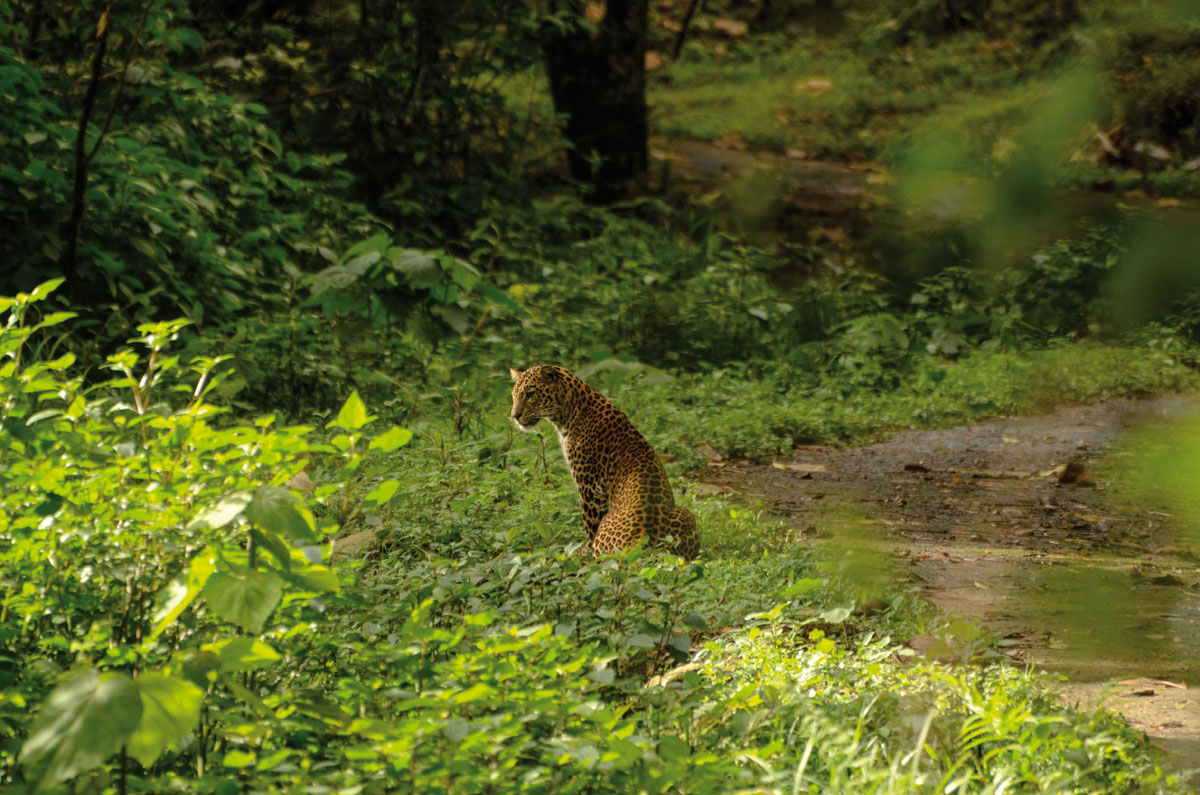
A leopard spotted in the Anamalai Tiger Reserve. Photo: P. Jeganathan.
The seeds are regularly collected, or “rescued” as Kshama puts it, from the margins between rainforest fragments and the commercial plantations that have colonised most of the Valparai Plateau. They are also picked up from civet and bear scat, under hornbill nests and bat roosts, and along the project’s phenology trail within the Anamalai Tiger Reserve (from tar roads, where they wouldn’t survive). They are brought to the nursery, washed, and sowed in a mixture of rainforest soil, bio-compost and coco peat. About 150 of the 400-odd tree species found in the Anamalai Mid-Elevation Wet Evergreen Forests have been successfully grown at the nursery. Diverse tiers of the rainforest, from shrub layer to overstory, are all represented here.
Over 3,000 saplings were planted in restoration plots over the last couple of weeks; another 2,000 will go out soon. The small plot in which we planted 250 saplings this afternoon is part of a 15 to 20 ha. patch of rainforest. This fragment is important for animal movement; it connects to the tiger reserve just past the river and to fragments on the other side. It’s a preferred location for Great Hornbills and there’s a troop of lion-tailed macaques in the area.
NCF has mapped around 50 such fragments across the plateau, of which 34 (~1,120 ha.) are being protected through MoUs with Parry Agro Industries Ltd. and Tata Coffee Ltd. An area of about 100 ha. has been targeted for active restoration efforts across 28 fragments: 80 hectares has been weeded and planted with a high diversity of species, with 20 hectares weeded for assisted natural regeneration and direct seeding experiments.
Size Doesn’t Matter
Some of the fragments are very small (0.3 ha.) and the forest is quite degraded – open canopy, proliferation of invasive species, decline in native plant diversity, lack of seed dispersers – but there is still significantly greater biodiversity here than in the surrounding green deserts, the commercial plantations. “Size doesn’t matter, quality does,” declares NCF programme manager Srinivasan Kasinathan. “These fragments still have a lot of biodiversity value and are movement corridors for wildlife. The idea is to restore them with reference to our benchmark sites in the tiger reserve, which is a relatively undisturbed, mature old-growth forest.”
We explore several restoration plots over the next few days and visit the Candura fragment in Parry Agro’s Murugalli Estate, where an interesting comparison between various restoration methodologies (active restoration, natural regeneration, assisted natural regeneration) is being conducted on different plots. A control plot has also been established in the secondary forest here and variables such as stand density, species richness, carbon storage and natural regeneration are being assessed there as in the experimental plots. Finally, we visit the Manambolli benchmark site within the Anamalai Tiger Reserve, where the trees are taller, denser and more diverse and the canopy closes out the sky. This is the rainforest as it once was, all across the plateau.
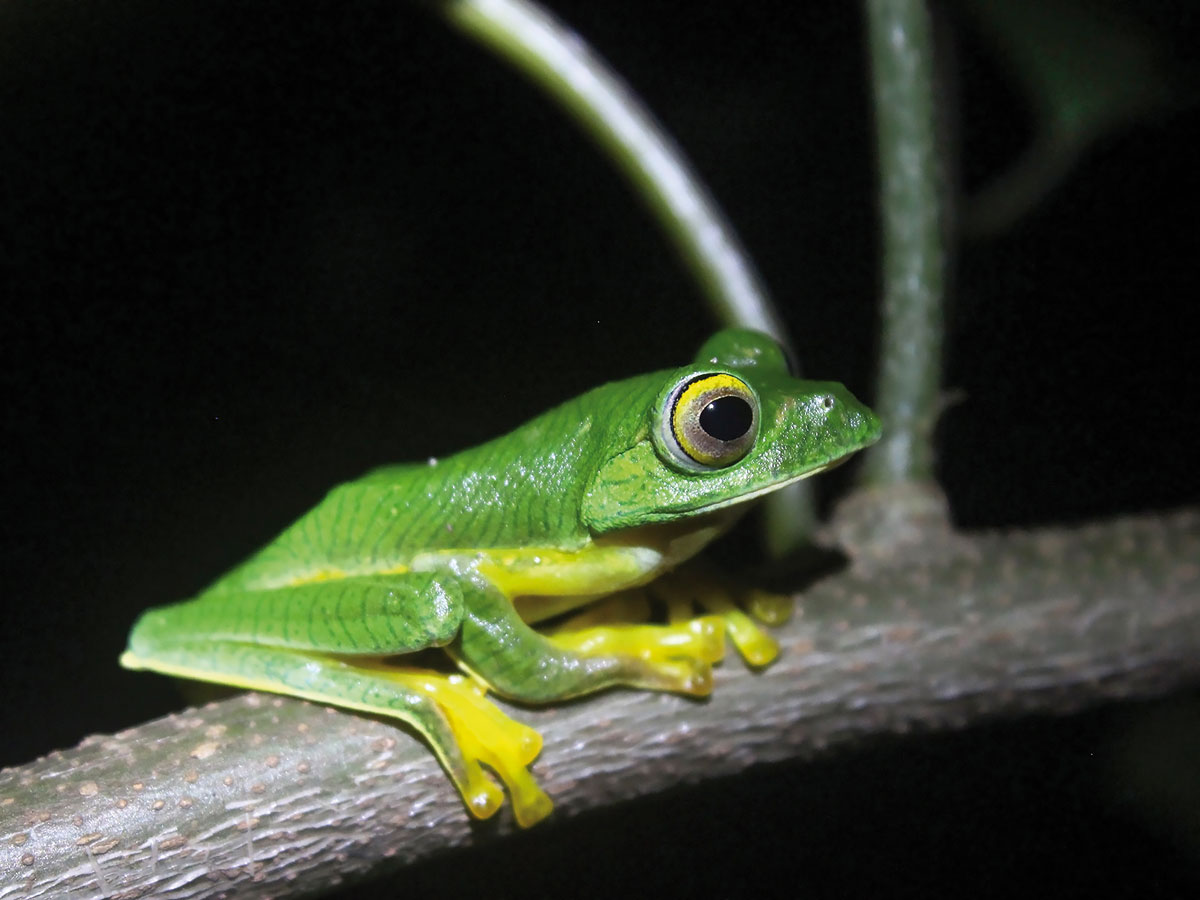
A Malabar gliding frog Rhacophorus pseudomalabaricus, a tree frog found in the Anamalai Hills. Photo Courtesy: Vijay Karthick.
Monitoring conducted on restored plots seven to 15 years after planting indicates that active restoration has led to better recovery than passive restoration in comparable sites, in terms of better canopy cover, tree density and species density, as well as compositional similarity to the benchmark sites in Anamalai TR. Aboveground carbon storage in actively restored forests has been measured at 143.9 Mg/ha (mean value), relative to naturally regenerating sites (49.0 Mg/ha) and benchmark rainforests (287.6 Mg/ha). Recent research has also shown that the actively restored sites support a greater diversity of rainforest birds and have a greater similarity to the bird community composition in benchmark rainforests.
Building An Alliance
One morning, I tag along as NCF senior scientists Divya Mudappa and T.R. Shankar Raman, who started the Anamalai Rainforest Restoration Project over two decades ago, visit one of the larger coffee estates on the plateau. We meet the estate manager, who talks about his plan to plant 10,000 trees on the estate (arabica coffee is shade-grown) under the Tamil Nadu Green Mission. Wonderful, except the saplings he’s buying are all exotics: mahogany and silver oak. He also wants to plant eucalyptus and red gum to dry up the swamps in the low-lying areas of the estate, because they’re “too slushy”.
Divya patiently explains that swamps are vital for the water table, especially with the reduced rainfall in recent years. Besides, the elephants and gaur that feed in such areas will be forced to move to other parts of the estate, potentially increasing conflict. As for shade trees, ensuring a diversity of native species, which are more resilient, will prevent mass die-offs on account of infection or extreme weather.
Shankar later tells me that the Forest Department has been distributing silver oaks to plantation owners in the Nilgiris to “increase tree cover”. “It’s particularly important to get the Forest Departments, not just in Tamil Nadu but across the country, to move away from behaviours they’re entrenched in,” he says. “They have hundreds of nurseries with hundreds of thousands of seedlings, but often only a handful of species. If they propagate species inappropriate to their eco-regions, never mind pushing ornamentals and exotics, that’s very unfortunate.”
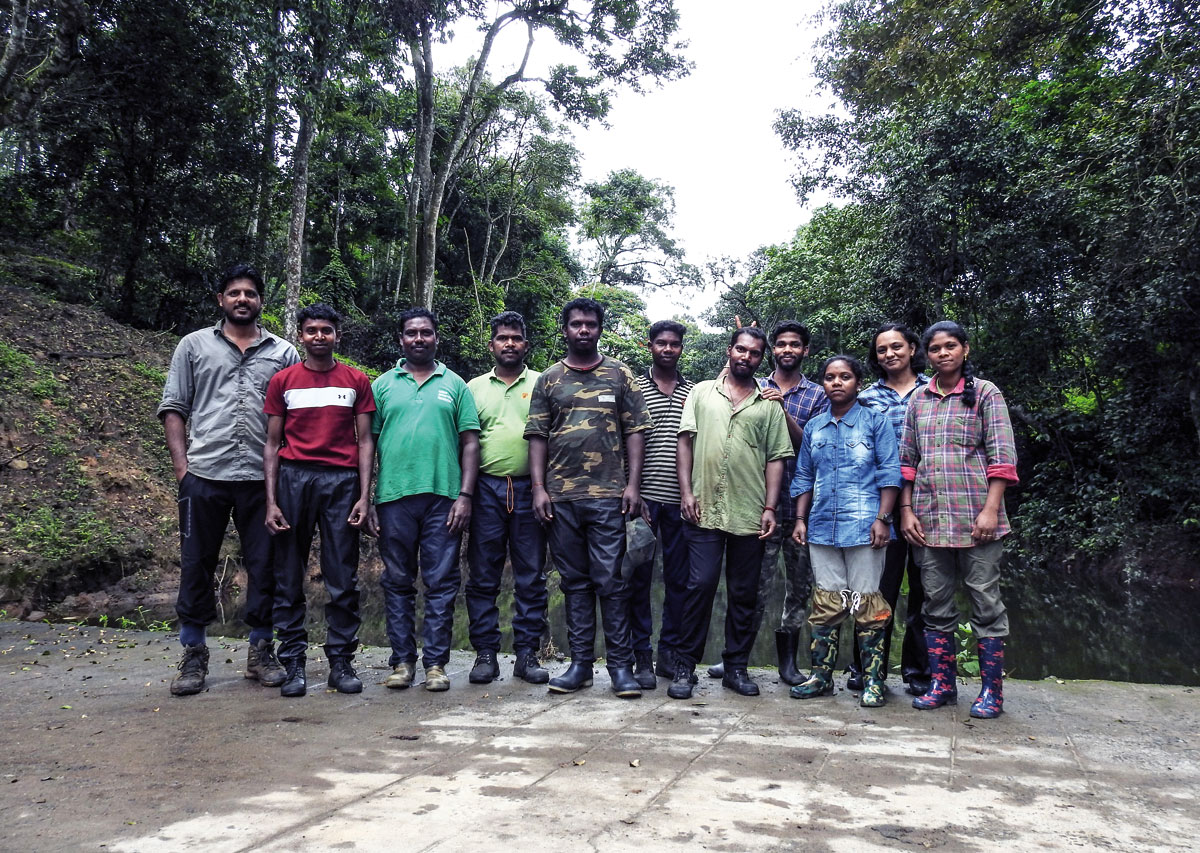
NCF’s restoration planting team after a morning’s work at the Varattuparai site. Monitoring conducted on restored plots seven to 15 years after planting indicates that active restoration has led to better recovery than passive restoration in comparable sites, in terms of better canopy cover, tree density and species density. Photo: Pranav Capila.
With a view to changing the mindset of both government and civil society entities engaged in (mindless) large-scale tree planting, Divya and Shankar recently joined a group of restoration practitioners in launching the Ecological Restoration Alliance (ERA).
“We come with a certain type of training as scientists, but there are also people, for instance from Indigenous communities, who are working on restoration projects,” Divya says. “Or, there are people who are doing parks but in an ecologically sensitive manner, reflecting local biodiversity. We felt that all these approaches had some features and strengths that could be useful to people who are just starting out on projects, or who are setting aside pieces of land, private or corporate.”
“No single person or group engaged in ecological restoration can possibly do it at very large scales,” Shankar adds. “A better way to do it is for lots of groups to take on smaller areas in which they have a presence and which they are committed to conserving. ERA is trying to create a platform where people can learn what others are doing and possibly apply it in their context.”
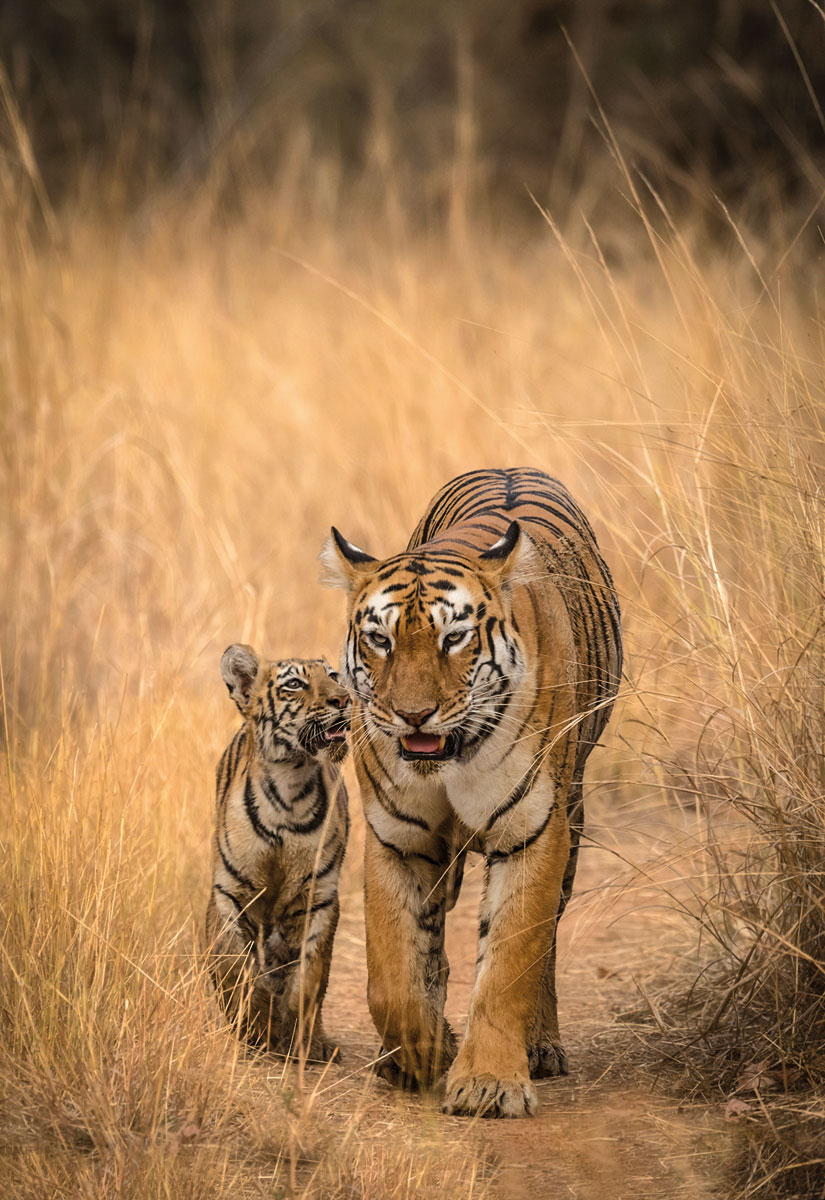 A tigress with her cub in a grassland in the Tadoba-Andhari Tiger Reserve core. Domain expert Dr. Gajanan Muratkar explains that grasses are the architects and engineers of the forest ecosystem – they prevent rainwater run-off, maintain soil nutrient levels, and provide suitable habitats. Photo: Mohammad Junaid.
Grass Is For Tigers
A tigress with her cub in a grassland in the Tadoba-Andhari Tiger Reserve core. Domain expert Dr. Gajanan Muratkar explains that grasses are the architects and engineers of the forest ecosystem – they prevent rainwater run-off, maintain soil nutrient levels, and provide suitable habitats. Photo: Mohammad Junaid.
Grass Is For Tigers
Last year, while on assignment with the Tadoba-Andhari Tiger Reserve (TATR) Conservation Foundation, I got a close-quarters view of some of the habitat improvement measures that the TATR management was undertaking within the core area of the reserve. Grassland development is an important part of these measures and a three-year project, funded by the State CAMPA and ICICI Foundation, has recently been initiated with domain expert Dr. Gajanan Muratkar to restore, maintain and improve grassland ecology within the Critical Tiger Habitat.
Dr. Muratkar heads the Botany and Environmental Science Department of the Arts, Science and Commerce College at Chikhaldara, on the edge of the Melghat Tiger Reserve. When we met last year, he was as keen as only a good teacher can be to talk about his favourite subject. “Grasses are the architects and engineers of the forest ecosystem,” he explained. “They prevent rainwater run-off, maintain soil nutrient levels, and provide suitable habitat for microbiota as well as grazing, browsing, hiding and breeding habitat for prey and predators.”
At TATR, Dr Muratkar has developed a 16-point protocol to ensure the propagation of indigenous grass species, remove ornamental exotics and invasive weeds, foster the growth of wild leguminous plants (which fix biological nitrogen and enrich the soil), and reduce woody species while preserving fruiting trees. He has also recommended that that the Important Value Index of various grassland species be assessed every two years, a germplasm bank of indigenous grass species be established, and capacity building of frontline staff be stepped up.
The project’s long-term aim is to increase grassland habitat in the TATR core by about 10 per cent. Already, as a result of these interventions, the grasslands of Jamni, Navegaon and Palasgaon – areas within the core where villages that have been rehabilitated once stood – are now seeing healthy prey populations as well as breeding tigresses.
The Long Arc Of Time
In 2021, the United Nations Environment Programme (UNEP) and the Food and Agriculture Organisation (FAO) released a report detailing the “state of degradation of the world’s ecosystems”. It revealed that ecosystem degradation affects the well-being of approximately 40 per cent of the world’s people, puts up to $577 billion in annual global crop production at risk from pollinator loss and annually causes the loss of ecosystem services worth more than 10 per cent of global economic output.
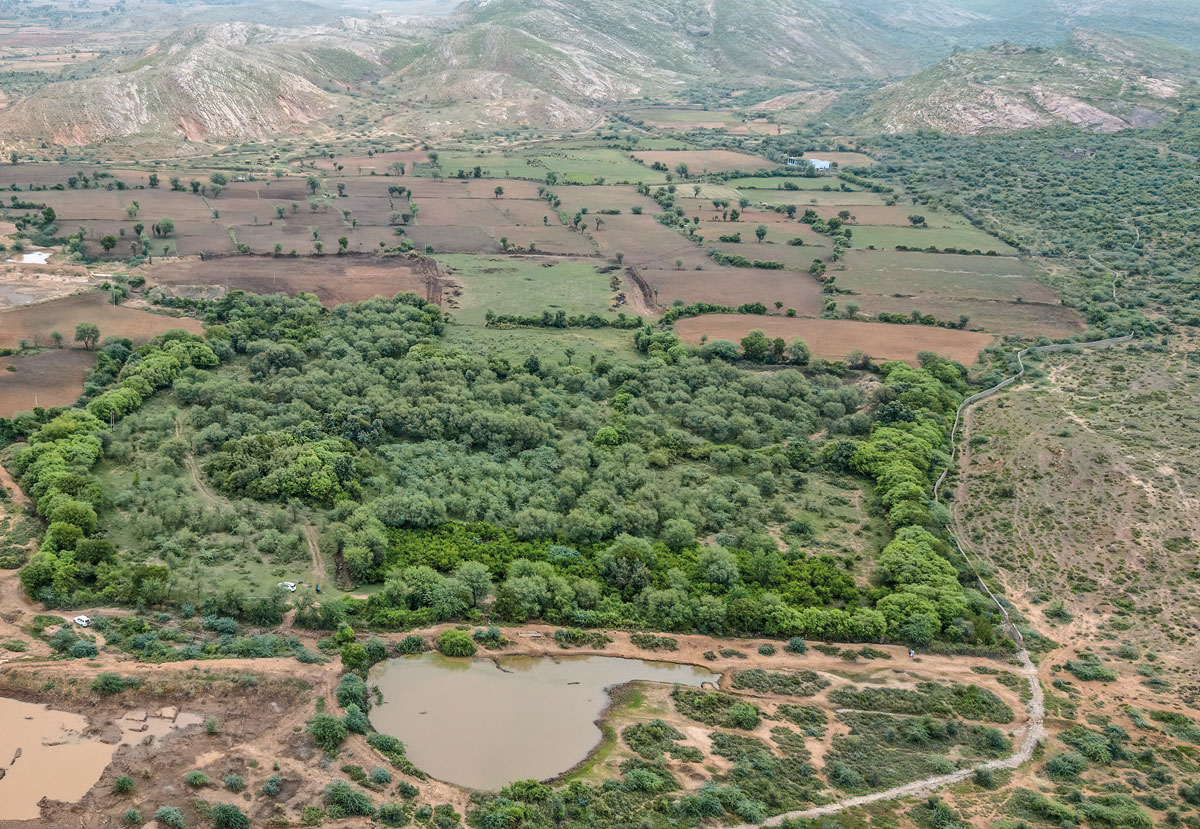
The late Aditya Singh and his wife Poonam bought 35 acres of land adjoining the Ranthambhore Tiger Reserve and successfully rewilded it over the course of 20 years. Photo: Aditya Singh.
An IUCN ‘Issues Brief’ released in February 2021 declared that “halting loss and degradation of forest ecosystems and promoting their restoration have the potential to contribute over one-third of the total climate change mitigation that scientists say is required by 2030 to meet the objectives of the Paris Agreement”. A study published in Nature (‘Global priority areas for ecosystem restoration’, Strassburg et. al.) found that “restoring 15 per cent of converted lands in priority areas could avoid 60 per cent of expected extinctions while sequestering 299 gigatonnes of CO2 – 30 per cent of the total CO2 increase in the atmosphere since the Industrial Revolution. The inclusion of several biomes is key to achieving multiple benefits.”
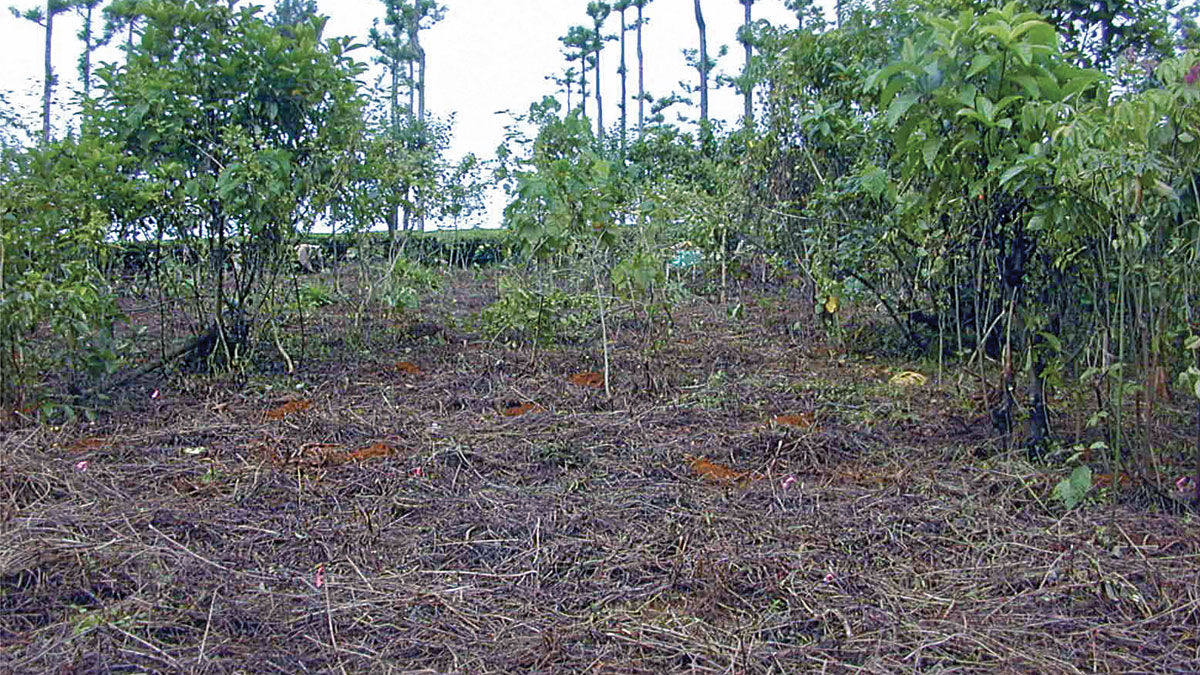
The degraded Injipara rainforest fragment on the Valparai plateau after weeding in 2004. Photo Courtesy: NCF.
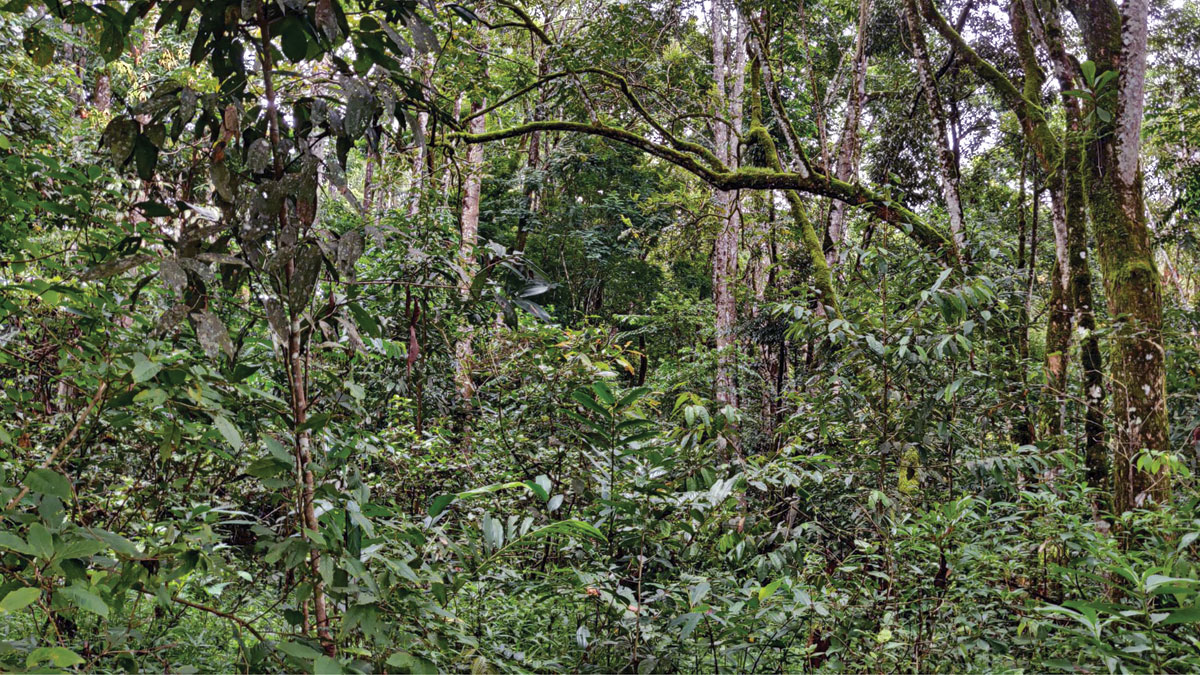
And recently, in 2023, two decades after restoration work commenced on the fragment. Photo Courtesy: NCF.
Ecological restoration offers comprehensive, nature-based solutions to conserving biodiversity and stabilising the Earth’s climate. However, there are two key caveats in the studies mentioned above: (a) “halting loss and degradation and promoting restoration,” because while ecological restoration can mitigate the mistakes of the past, it cannot compensate for the mistakes of the future (to believe that would be, once again, missing the forest for the trees), and (b) “the inclusion of several biomes,” because non-forest, non-terrestrial ecosystems need more attention than they are getting.
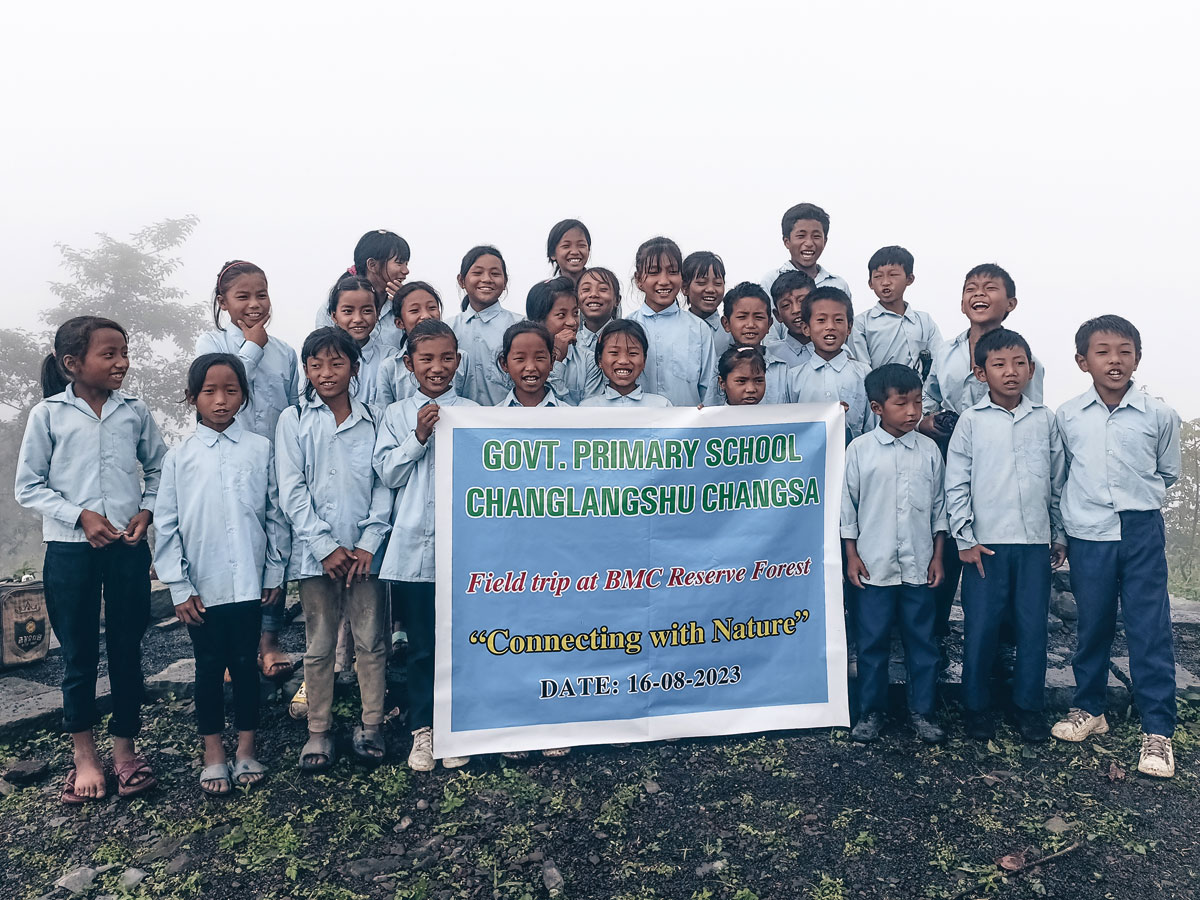
A nature education field trip conducted in August 2023 for school children from the Changlangshu Government Primary School. Photo: Nayantara Siruguri.
What is wonderful about the ecological restoration space is that there is room for a variety of players – for community practitioners such as Wanmei Konyak, scientists such as Divya Mudappa and T.R. Shankar Raman, and self-taught practitioners such as Vijay Dhasmana. There is room for Forest Departments and governments; in fact, it is essential that they get past their tree-planting quick-fix and get on board, since they have the capacity to scale such projects like no individual or private organisation can. There is room for corporates, though a certain re-education is required, since CSR is oriented towards short-term outcomes and the arc of time is long with ecological restoration. There is room for dedicated individuals such as Poonam and Harshwardhan Dhanwate, who let a patch of the Tadoba-Andhari buffer rewild, and the late Aditya Singh and Poonam, who created their own little forest heaven next to Ranthambhore. Someday, when I have acquired sufficient resolve, there will be room for me.





















